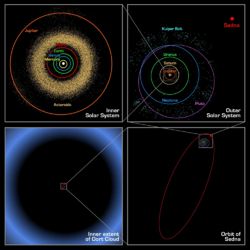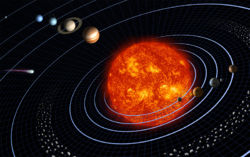Kuiper Belt
 From Conservapedia
From Conservapedia | Kuiper Belt |
 NASA diagram shows the presumed distance of the Oort Cloud compared to the Solar System planets, the Kuiper Belt, and the orbit of Sedna. |
The definition of the Kuiper belt appears somewhat confused. Some astronomers appear to use the terms "Kuiper belt object" (KBO) and "trans-Neptunian object" (TNO) to refer to the same class of objects.[1][6] This is not correct. A trans-Neptunian object is any object having a semi-major axis higher than that of Neptune. A Kuiper belt object is an object that remains between 30 AU and 50 AU distant from the Sun. Thus the Kuiper belt is a subset of trans-Neptunian objects.[7]
The conflation of the terms TNO and KBO persists, with some astronomers using the term "classic KBO" to refer to any object lying within the strict bounds of the Kuiper belt.[6]
Contents
- 1 Recognition
- 2 Composition
- 3 The Short-Comet Theory
- 4 Observation and exploration
- 5 References
- 6 Related Links
- 7 See also
Recognition[edit]
Technically the first object belonging to the Kuiper belt to be discovered was Pluto in 1930. Next to be discovered was Charon, the moon of Pluto, in 1978.[8] However, the first discovery that caused the astronomical community to recognize the Kuiper belt as a real collection of bodies in the solar system was that of 1992 QB1 in August 1992.[8]
Composition[edit]
The number of objects that the Kuiper belt contains is confused. Jewitt estimates more than 70,000,[1] but independent corroboration of this number is singularly lacking. Parker[9] counted 651 as of January 2003. Furthermore, Jewitt states that the 70,000 objects he estimates have diameters of 100 km or greater. Wilson[8] calls these "super-comets" thus emphasizing that they are far larger than true comets.
Delsanti and Jewitt[10] now estimate that the total mass of all objects in the Kuiper belt cannot be more than one-tenth the mass of the Earth. The primary basis of this new estimate is that Kuiper belt objects are now known to be much brighter than originally supposed, and brighter than the members of the Jupiter family of comets.
The composition of these objects is believed similar to that of the dwarf planets Pluto and Eris.
The Short-Comet Theory[edit]
Short-period comets include all those having periods less than 200 years.[11][12] Almost all of these are prograde, and their orbits are only slightly inclined to the ecliptic.[13]
The near-universal consensus among secular astronomers is that the Kuiper belt is the source of short-period comets. But the evidence from current observation poses many problems for this theory. First, as Delsanti and Jewitt have admitted, the total mass of the Kuiper belt is severely limited—to ten percent of the mass of the earth, including the masses of Pluto and its moon Charon. Second, the objects known to exist in the Kuiper belt (however many there may be) have diameters of 100 km or greater, far greater than the diameter of any comet head. Third, even the 70,000 objects that Jewitt estimates that the Kuiper belt contains is far fewer than the billion or so objects that would actually be required to supply short-period comets over the presumed 4.5-billion-year age of the solar system.[14] Fourth, some of these objects, like Pluto, are in orbits that are severely inclined to the ecliptic, totally unlike the short-period comets to which they are supposed to give rise.
Champions of the short-comet theory contend that actual short-period comets result from fragmentation of the large KBOs or else are simply too dim for Earth-based telescopes to observe.
Observation and exploration[edit]
The only observation of the Kuiper belt or of the objects within it has been by Earth observatories and the Hubble Space Telescope. However, the New Horizons mission, launched on January 19, 2006, will arrive in the Belt in 2015, first to explore Pluto and its moons, and then to explore at least one other KBO. The Panoramic Survey Telescope and Rapid Response System (Pan-Starrs) survey project[15] should be completed by then, and its findings might assist New Horizons mission planners in selecting their next target after Pluto.[11]
References[edit]
- ↑ 1.0 1.1 1.2 Jewitt, David. "Kuiper Belt." University of Hawaii, n.d. Accessed June 20, 2008.
- ↑ Arnett, Bill. "The Kuiper Belt and the Oort Cloud." The
Nine8 Planets, March 18, 2007. Accessed June 20, 2008. - ↑ Hamilton, Calvin J. "The Kuiper Belt." Views of the Solar System, 2001. Accessed June 20, 2008.
- ↑ "Edgeworth-Kuiper Belt and Dust Disk." Sol Company, 2008. Accessed June 20, 2008.
- ↑ "The Kuiper Belt." SpaceTech's Orrery, n.d. Accessed June 20, 2008.
- ↑ 6.0 6.1 Johnston, William Robert. "Trans-Neptunian Objects." The Johnston Archive, October 1, 2007. Accessed June 20, 2008.
- ↑ Faure, Gérard. "Description of the System of Asteroids as of May 20, 2004," Richard Miles, trans. Accessed June 20, 2008.
- ↑ 8.0 8.1 8.2 Wilson, G. "The Kuiper Belt." n.d. Accessed June 20, 2008.
- ↑ Parker, Joel W. "News and Announcements." Distant EKO's: The Kuiper Belt Electronic Newsletter, issue 27, January 2003. Accessed June 20, 2003.
- ↑ Delsanti, Audrey, and Jewitt, David. "The Solar System Beyond the Planets." 2006. Accessed June 20, 2008.
- ↑ 11.0 11.1 Weisstein, Eric W. "Oort Cloud." Eric Weisstein's World of Astronomy, 1996-2007. Accessed June 2, 2008
- ↑ Faulkner, Danny. "Comets and the Age of the Solar System." TJ, 11(3):264-273, December 1997. Accessed June 2, 2008.
- ↑ Brown, Walt. "How Comets Move." In the Beginning: Compelling Evidence for Creation and the Flood, June 16, 2008. Accessed June 20, 2008.
- ↑ Newton, Robert. "[Kuiper Belt Objects: Solution to Short-period Comets]?" TJ 16(2):15-17, August 2002. Accessed June 20, 2008.
- ↑ "Pan-Starrs Home."
Related Links[edit]
- List of known trans-Neptunian objects. Harvard University.
- Lisle, Jason. "The 'tenth planet' is discovered." AiG–USA August 5, 2005. Accessed June 20, 2008.
- Sarfati, Jonathan. "Comets-portents of doom or indicators of youth?." Creation 25(3):36–40, June 2003. Accessed June 20, 2008.
See also[edit]
- Astronomy
| |||||||||||||||||||||||||||||
Categories: [Astronomy]
↧ Download as ZWI file | Last modified: 02/14/2023 03:21:23 | 26 views
☰ Source: https://www.conservapedia.com/Kuiper_Belt | License: CC BY-SA 3.0
 ZWI signed:
ZWI signed:
 KSF
KSF